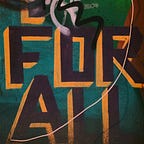Beyond the social model of disability: What does it mean for those with an intellectual disability?
In recent times there has been a shift in how the disabled community look at themselves. More and more disabled people are identifying with their disability and promoting pride with their disability. To be clear, I am not saying this is bad — in fact it is a significant and important shift forward as people engage and rightfully demand their place in society.
Sheri Byrne-Haber, CPACC addresses this in her Medium article “Is an ‘identity model’ replacing the charitable, medical, and social models of disability? The next stage of evolution in how the global community views disability” . As a disabled person herself she embraces the shift of disabled people integrating their disability into their identity and using their empowerment for positive social change.
The singer/songwriter Sia was recently slammed for casting a non-disabled girl into a role of an autistic girl in her movie. Sia apologized for not having researched widely enough to get all the perspectives on her choices to do so. There are many things Sia could do differently and thankfully she accepted the criticism and took it on with humility.
The social model of disability reveals the social structures that disable someone from participating and accessing society, laying bare the policies, buildings, curriculums and attitudes that create barriers for all disabled people.
A related theory, Social Role Valorisation (Wolf Wolfensberger), supports the social model by assigning valued roles to devalued people, to shift societal perceptions of them. This is a particularly useful framework for people with intellectual disabilities. I’ve seen this play out time and again — the sing song voice of condescension often used when interacting with a disabled person, is replaced by a respectful engagement, often resulting in a meaningful connection that would not have occurred otherwise. Of course, people should just be accepting of everyone. But that’s not how our world works and it needs intentional strategies for perceptions to shift. Creating valued roles remains an important strategy for inclusion and relationship building for people with intellectual disabilities.
Intellectual and developmental disability is at the bottom of the disability hierarchy. Ed Roberts talks about the importance of identifying with their disability, but also explains the hierarchy of disability well. Disabled people and their families can be quick to distance themselves from intellectual disabilities by saying ‘I am intelligent’, inferring they are not one of ‘them’ and their disability is not ‘that one’.
People with intellectual disabilities are routinely shut out from mainstream society and placed in ‘special’ places. Attempts to include are still met with disdain and resistance by educational institutions, community organisations and employers alike. So often they are told there’s a place for ‘them’ already — special Olympics, special schools, group homes, sheltered workshops. Places that we know are routinely incubators for abuse and neglect.
Further, the person themselves who experiences a significant intellectual disability may not be cognitively aware of these discriminations, or thoughtfully engaged by others in the discourse, because they may not think they have a disability at all. They live the consequences of these discriminations though, every day.
So where does the identity model leave them?
After many years of advocacy for inclusion resulting in de-institutionalisation, more inclusive policies in our societal structures and some steps forward to being embraced by our communities, we are witnessing a shift back to division, albeit in a different way.
It’s disheartening to witness this group of people being let down yet again.
